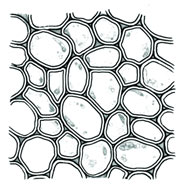What are tissues?
The group of cells performing similar tasks collectively is called tissue. Tissues organize the body of an organism. Many types of tissues are associated with each other to perform efficiently and from the tissue system. Parenchyma is the simplest ground tissue in plants. This article will discuss the definition, origin, shape, structure, and functions of parenchyma tissues.
Definition of Parenchyma
The simple tissues having thin and elastic walled cells and are continuous throughout the plant body are called parenchyma tissues.
The word parenchyma originated from the Greek word parénkhyma, or from “parenkhein“, indicating “close to”, “to pour in” whereas énkhuma implies ” content of a vessel”.
Origin:
Parenchyma is mainly primary in origin. But they are also produced as a result of secondary growth. Parenchyma cells present in the main plant body, i.e., pith and cortex, originates from the ground meristem.
Procambium and cambium also give rise to the xylem and phloem parenchyma of the primary and secondary cells specifically. Phelloderm stems from phellogen. In leaves, protoderm and ground meristem trigger parenchymatous epidermis and mesophyll respectively.
Shapes
The parenchyma has different shapes.
- Polyhedral
The cells are mainly polyhedral in shape.
- Stellate
These parenchymas are discovered in the stems of plants and they have actually well-established air spaces in between them.
- Elongated
Elongated parenchyma cells are found in the palisade tissue of the leaf.
- Lobed
Lobed parenchymas are found in spongy and palisade mesophyll cells of some plants.
Structure of Parenchyma
Parenchyma in plants is discovered to be a living cell. It has a prominent and active protoplast and nucleus. Parenchyma in plants cells is either polyhedral or isodiametric. They can likewise be oval, polygonal, lengthened, or round.

They have a thin cell wall surface that is chiefly made up of cellulose, hemicellulose. Cells of the parenchyma cells are joined up by plasmodesmata. They have actually obtained some little vacuoles. Smaller vacuoles integrate to become a big central vacuole in the older parenchyma, that may absorb anthocyanin or tannins.
These cells are closely loaded. Yet intercellular areas are produced by the dissolution of the middle lamella. These air spaces are common for the exchange of gases. Aerenchymas have prominent intercellular spaces.
Functions of Parenchyma
These tissues have less specialized cells but they execute significant tasks in the cell.
- Meristematic:
They resume meristematic activity under certain special conditions. These conditions might be regeneration, wound healing, development of adventitious roots as well as the union of grafts.
Some Parenchymas are associated with photosynthesis. The parenchyma cells of mesophyll cells of leaves are abundant in the chloroplast. They are called assimilatory parenchyma.
- Storage:
Parenchyma additionally stores food in fruits and roots, and so on. They are called storage parenchyma. They have lots of leucoplasts in their cells. They keep starch, fats, oils, and also other granules. Storage parenchymas are frequently found in the cortex of stem, roots, and seeds.
- Ground Cells:
They serve as ground cells in most plants.
- Secretory and Excretory structures:
In certain cases, these parenchymas have secretory and excretory features.
- Pigmented cells
Parenchyma cells of flowers and fruits have chromoplasts that provide various colors to flowers and fruits.
- Storage of Water
The parenchyma cells of succulent plants store water. These cells are huge with thin cell walls. They have a thin layer of cytoplasm. These cells have large vacuoles. These vacuoles consist of mucilaginous sap which enhances the water holding capacity of the cell.

